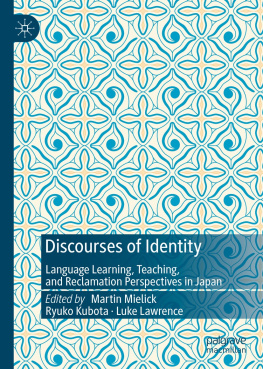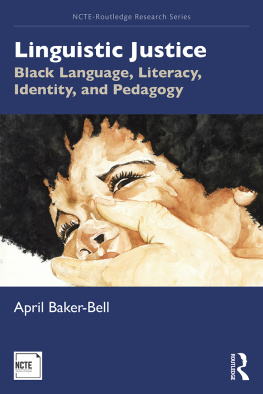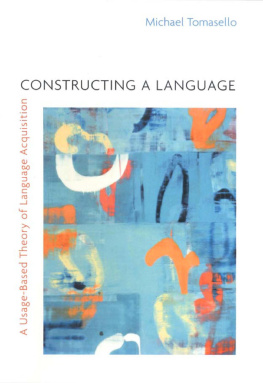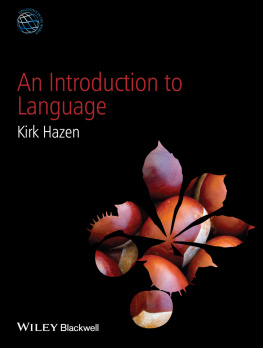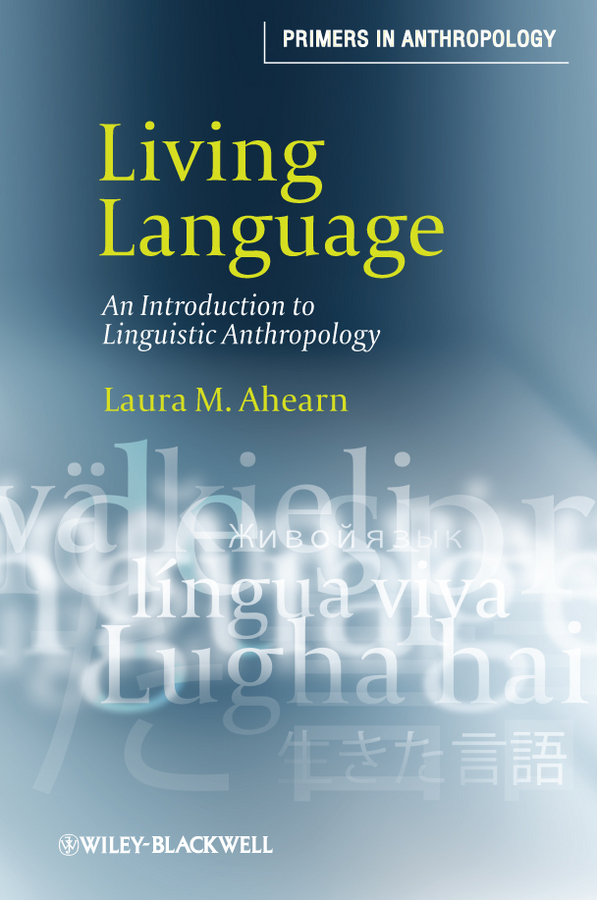Contents
Blackwell Primers in Anthropology
Each volume in this series is a lively first look at a traditional area of anthropological study. These concise books provide theoretically sophisticated yet accessible and engaging introductions for nonspecialists. They will be invaluable for undergraduate instruction as well as offering pithy overviews to those unfamiliar with the primary issues in the chosen subdiscipline.
Published
1. People and Nature: An Introduction to Human Ecological Relations by Emilio F. Moran
2. Living Language: An Introduction to Linguistic Anthropology by Laura M. Ahearn

This edition first published 2012
2012 Laura M. Ahearn
Blackwell Publishing was acquired by John Wiley & Sons in February 2007. Blackwells publishing program has been merged with Wileys global Scientific, Technical, and Medical business to form Wiley-Blackwell.
Registered Office
John Wiley & Sons Ltd, The Atrium, Southern Gate, Chichester, West Sussex, PO19 8SQ, United Kingdom
Editorial Offices
350 Main Street, Malden, MA 02148-5020, USA
9600 Garsington Road, Oxford, OX4 2DQ, UK
The Atrium, Southern Gate, Chichester, West Sussex, PO19 8SQ, UK
For details of our global editorial offices, for customer services, and for information about how to apply for permission to reuse the copyright material in this book please see our website at www.wiley.com/wiley-blackwell.
The right of Laura M. Ahearn to be identified as the author of this work has been asserted in accordance with the UK Copyright, Designs and Patents Act 1988.
All rights reserved. No part of this publication may be reproduced, stored in a retrieval system, or transmitted, in any form or by any means, electronic, mechanical, photocopying, recording or otherwise, except as permitted by the UK Copyright, Designs and Patents Act 1988, without the prior permission of the publisher.
Wiley also publishes its books in a variety of electronic formats. Some content that appears in print may not be available in electronic books.
Designations used by companies to distinguish their products are often claimed as trademarks. All brand names and product names used in this book are trade names, service marks, trademarks or registered trademarks of their respective owners. The publisher is not associated with any product or vendor mentioned in this book. This publication is designed to provide accurate and authoritative information in regard to the subject matter covered. It is sold on the understanding that the publisher is not engaged in rendering professional services. If professional advice or other expert assistance is required, the services of a competent professional should be sought.
Library of Congress Cataloging-in-Publication Data
Ahearn, Laura M., 1962
Living language : an introduction to linguistic anthropology / by Laura M. Ahearn.
p. cm. (Blackwell primers in anthropology)
Includes bibliographical references and index.
ISBN 978-1-4051-2440-9 (hardback) ISBN 978-1-4051-2441-6 (paperback) 1. Anthropological linguistics. 2. Language and culture. I. Title. II. Series.
P35.A38 2011
306.44dc22
2010049292
A catalogue record for this book is available from the British Library.
This book is published in the following electronic formats: ePDFs 9781444340532; Wiley Online Library 9781444340563; ePub 9781444340549
For Mellie,
whose words and smiles
have brought me indescribable joy
Figures
1.1 | Cartoon demonstrating how certain styles of speech can both reflect and shape social identities |
1.2 | Khim Prasad during the Pounded Rice Ritual, with the bride, Indrani Kumari, and the bridal attendant |
1.3 | Cartoon about the varying cultural meanings associated with language use |
1.4 | Jakobsons model of the multifunctionality of language |
1.5 | Cartoon playing off the language ideology that considers French a romantic language |
1.6 | Semiosis as a relation between relations |
3.1 | The cultural concepts of hed and save in Gapun, Papua New Guinea |
4.1 | Relationship between language and thought according to the (mistaken) strong version of the SapirWhorf Hypothesis |
4.2 | Relationship among language, thought, and culture according to contemporary understandings of the SapirWhorf Hypothesis within linguistic anthropology |
4.3 | Another of the many representations in popular culture of the Eskimo words for snow myth |
4.4 | Set-up for experiment involving coordinate systems |
5.1 | De Saussures linguistic community |
5.2 | Santa Ana and Parods model of nested speech-community configurations |
5.3 | Strong, multiplex, high-density network with individual X at center |
5.4 | Weak, uniplex, low-density network with individual X at center |
6.1 | Peter Auers continuum of codeswitching,language mixing, and fused lects |
7.1 | Nepali love letter (with all identifying features removed) |
8.1 | Spatial configuration at August 1990 Tij songfest in Junigau |
9.1 | Cartoon referring to author Deborah Tannens ability to understand gendered language |
9.2 | Cartoon showing how certain linguistic forms can index social identities |
10.1 | Political cartoon that appeared in the wake of the Ebonics controversy |
11.1 | Cartoon depicting normal and inevitable changes in a language over time |
12.1 | Doxa as that which is taken for granted and therefore outside the universe of discourse |
Tables
4.1 | English pronouns in the nominative case |
4.2 | Nepali pronouns in the Junigau dialect |
4.3 | Noun classes in Swahili |
4.4 | Spatial categorizing in English and Korean |
5.1 | Santa Ana and Parods typology of speech-community configurations |
7.1 | Be + like as a percentage of total quotatives in face-to-face and IM talk |
9.1 | Findings of Hydes meta-analyses regarding gender differences in communicative behavior |
11.1 | Ten most commonly spoken languages in the world |
Preface
Language as used in real-life social contexts is fascinating but extremely challenging to study. Linguistic anthropology as a discipline offers a set of concepts and tools for undertaking this challenge. My goal in this book is to provide an accessible introduction to the main principles and approaches of linguistic anthropology without overly simplifying the complex contributions of scholars in the field. To the degree that this book succeeds in accomplishing this goal, it will be useful not just to graduate and undergraduate students studying linguistic anthropology for the first time (to whom I very much hope to communicate my enthusiasm for the field) but also to all sorts of other readers who might for various reasons be interested in living language. These readers might include, for example, cultural anthropologists, sociologists, or political scientists who have never looked closely at language in their research but could benefit from doing so. I also hope the book will be of value to linguists whose work thus far has been more technical and abstract in nature but who would like to turn their attention to the study of actual instances of linguistic practice. And finally, I hope the book will appeal to anyone who has a natural curiosity about the central role language plays in shaping and reflecting cultural norms and social interactions.


